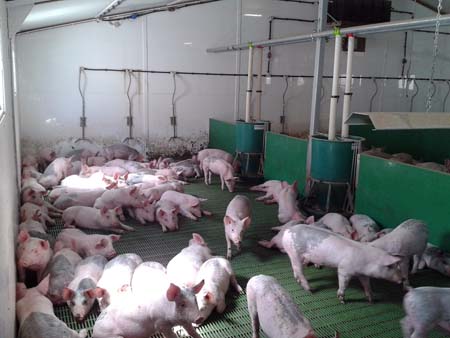
Do farmers understand temperature lift in a piggery and its implications for the pigs?
Tim Miller, environmental specialist with ARM Buildings suggests that this is not the case with many farmers. But, with warmer weather on the way, this is something that should be considered, he says.
Temperature lift is the term used to describe the difference between the outside (ambient) temperature and that inside a piggery during warm weather when the ventilation rate has reached its programmed maximum. This can affect the performance of all classes of housed pigs.
Recent research work at Hillsborough in Northern Ireland, for instance, has shown that reducing the temperature in farrowing houses is one of the easiest ways to improve sows feed intake and increase piglet weaning weights. It was suggested that air temperature should be lowered to 18°C once the last sow had farrowed, while ensuring that piglets are not chilled.
Tim miller says that in his experience temperature inside farrowing houses often soars to over 24°C when the outside temperature is 18°C and farmers believe the controllers are at fault. This can be much higher in hot weather.
He suggests that, where possible, temperature lift should be restricted to around 3°C-4°C. If this can’t be achieved then ventilation capacity should be increased, either by fitting extra fans or increasing the size of existing ones. Without air conditioning, or a misting system, it is obviously impossible to reduce the temperature within a house to below that of the outside ambient level.
He points out that temperature lift can also significantly affect finishing houses, particularly where farmers have switched from continuous to batch system. With continuous systems the average total weight of pigs is lower than the latter stages of batch systems when all the pigs are nearing finishing weight.
“The pigs’ heat output is considerably higher and this can cause problems in warmer weather where the ventilation systems weren’t originally designed for batch systems,” he said. “High temperatures reduce feed intake and slow growth rates.”
Monitoring has shown that finishing buildings which reach 28°C during the afternoon can drop to 18°C in the evening and pigs do not like these swings in temperature.
“In warmer weather, we suggest running a slightly higher set temperature which means the temperature doesn’t drop as rapidly in the evening. This also gives lower running costs,” said Tim.
“Just increasing fan capacity is not a solution — inlet area must also be enlarged.”
Generally, weaners and growers will put up with higher temperatures, he pointed out.
